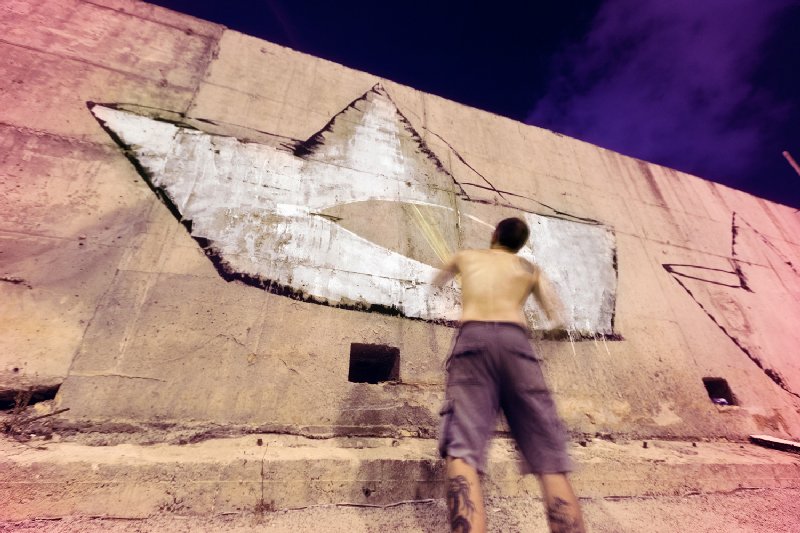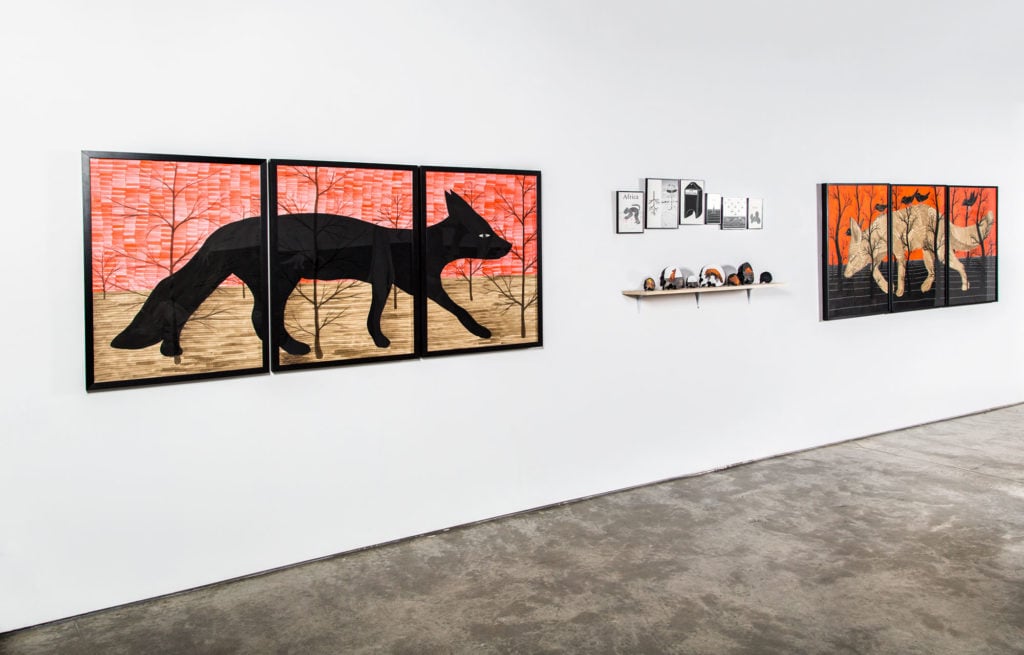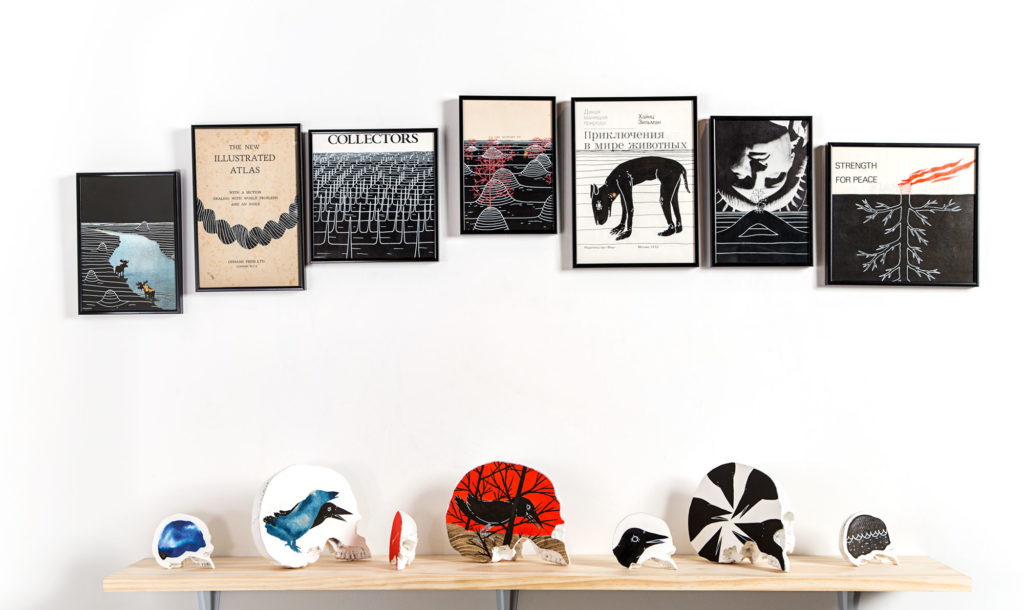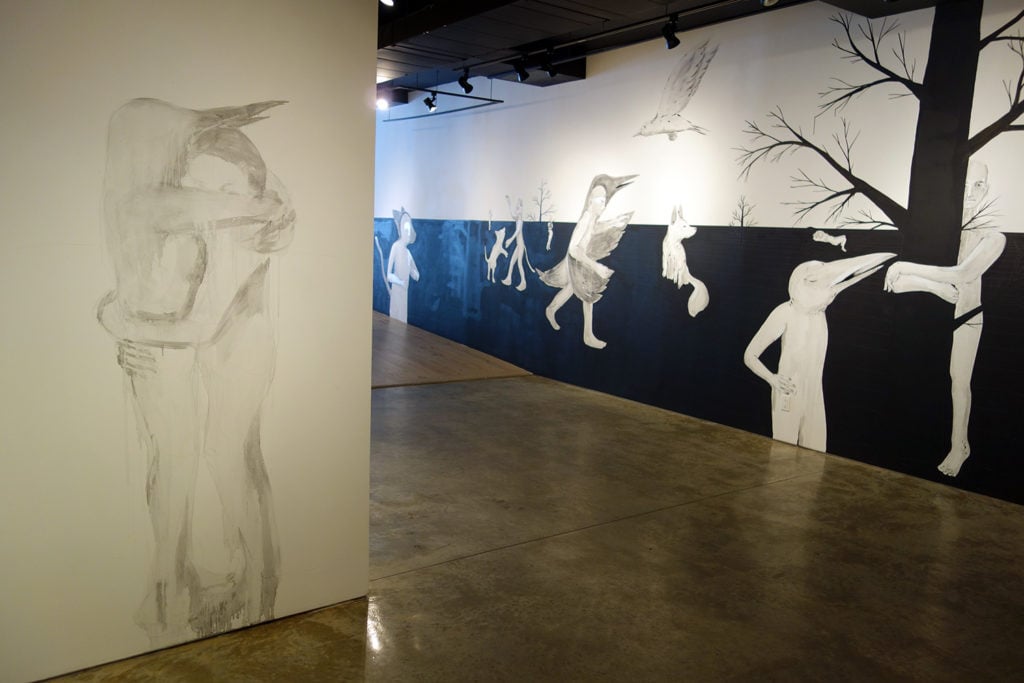Art & Exhibitions
artnet Asks: Israeli Artist Klone
Taking NYC by storm with a show at Garis & Hahn and a mural at Pioneer Works.

Taking NYC by storm with a show at Garis & Hahn and a mural at Pioneer Works.

Cait Munro


Klone, “Topography of a Daydream,” installation view.
Photo: Courtesy of Garis & Hahn.
Thanks to a solo show at Garis & Hahn and a new mural on display at Pioneer Works, Tel Aviv-based artist Klone is taking New York by storm. “Topography of a Daydream,” which will be on display at Garis & Hahn until June 20, is a thoughtful, layered show that references Western and Eastern culture, folklore, and the artist’s personal history through a series of drawings, paintings, sculptures, animations, and a site-specific installation. artnet News caught up with Klone to discuss the show, his studio practice, and his whirlwind entrée into the New York art world.
Congratulations on your first NYC solo show! What has your experience of the New York art scene been like?
Thank you! I recognized right away that this would be a shift from the ways I’ve worked in other cities across the world—even American cities.
It’s been interesting. The first night I landed, I had to go to a museum fundraiser. There were so many people there and I remember being more overwhelmed by that then anything. The amount of people that showed up was unlike anything I’ve seen—all the cameras, the introductions. As much as I enjoy experiencing new cultures, behaviors, and environments, at the end of the day I really just want to be in my studio working and seeing art without the obligation to socialize. It seems like emerging artists living here have to deal with balancing time to be in the studio and time to be at the parties, which I don’t do very well. It made me appreciate the situation I have in Tel Aviv—where it’s acknowledged and recognized that I need to be in the studio making work and so I don’t feel the same pressure to be out at every art event.

Klone, “Topography of a Daydream,” installation view.
Photo: Courtesy of Garis & Hahn.
Much of “Topography of a Daydream” comes from your own childhood memories. How do you translate such personal experiences into artworks that are meaningful even for people that are coming from very different backgrounds?
I’d like to believe the themes of my work are universal. Cultural and historical biographies will add an objective layer, but I imagine that the feelings of displacement, otherness, and of course, hope, are common. In using mythological creatures and references, my goal is to break the language barriers—to lose the “lost in translation” moment and make artwork that will be relevant and accessible now and in the future. The goal is to make the viewer experience and connect on his/her own level and understand that we’ve shared something together, no matter where we come from or how different we seem.
Can you tell us a bit about the process of installing the show?
It starts with an idea, but truthfully, I never really know how the show will look until I’m in the space with all the elements of the installation in there with me. When I came to New York I spent two days just being in the space before I even began to paint. I needed to feel and witness how the light changed, how people walked by, and the subtle differences between the day and the night. The first days are contemplative, then I get into the work—the sketching, the painting, the hanging, the arranging and the re-arranging. I spend the most time working on what their time inside the space will be, what it will feel like.
How does your street art and graffiti background influence the choices you make with your other art?
I think my street practice taught me a lot about the way people view things and how artwork is appreciated differently in different spaces. As an artist who does both public murals and works on paper, it’s important to address this difference across mediums. There is parallel between my street and studio work, but it is primarily in the theme. I believe that street art and graffiti is an intervention, perhaps even a reclaiming of public space, that politically only works in the streets. The gallery setting, on the other hand, has a different set of rules. All the information you have outside surrounding your work when it’s in a public space is taken away, and you need to understand how to work with the blank space, where to a degree, art is understood, intellectually, as sacred. It can’t be the same thing. On the most fundamental level, it taught me a lot about letting go of things easily and progressing on to the next step without stopping for too long.

Klone, “Topography of a Daydream,” installation view.
Photo: Courtesy of Garis & Hahn.
You also have a project currently on display at Pioneer Works, correct? What can you tell us about that?
After my exhibition opened I was invited to paint a mural on an outside wall of Pioneer Works, which I was really exited about knowing Dustin [Yellin]’s work and the ideas behind the space. I wanted the mural to connect with “Topography of a Daydream,” but at the same time be specific to this unique art space committed to innovation. Knowing the mission of the space and how they support creativity across disciplines made me want to step outside the box with this mural. The way I painted it allows for two different views. One as the mural. And one as, what I would call a “loop” painting. In the mural you do not see the crow in its entirety, but rather two ends; when you photograph the mural, you can connect them and create the full image. This piece is at the same time a mural, photograph, and video or just one of them. This was a way of making the work infinite—breaking the boundary of a specific frame, composition, and medium.
How did you decide on the name “Klone”?
Klone is a name that came from one of my first characters in 2004—when I was experimenting with images to change my graffiti tag. There’s also the more obvious nod to the word “clone” and the more complex concept dealing with societal expectations and histories repeating over and over.

Klone, “Topography of a Daydream,” installation view.
Photo: Courtesy of Garis & Hahn.
What’s a fun fact about you?
I didn’t learn how to ride a bicycle until I was 27.
Who are some artists who have influenced you?
I find great inspiration in the Old Masters that had the time, patience, and facility for precise execution—this is not a luxury I have working in the streets or with installations. I try to approach the planning in the same meticulous way, but the reality for my generation of artists is that we have to produce more and much quicker. To that end, I’m much more interested in watching the ways the current generation deals with the speed our lives and the general impatience and how artists challenge or adhere to that.